NanoImpact ( IF 4.9 ) Pub Date : 2021-03-26 , DOI: 10.1016/j.impact.2021.100313 Ilse Gosens 1 , Pedro M Costa 2 , Magnus Olsson 3 , Vicki Stone 4 , Anna L Costa 5 , Andrea Brunelli 6 , Elena Badetti 6 , Alessandro Bonetto 6 , Bas G H Bokkers 1 , Wim H de Jong 1 , Andrew Williams 7 , Sabina Halappanavar 8 , Bengt Fadeel 3 , Flemming R Cassee 9

|
Copper oxide nanoparticles (CuO NPs) have previously been shown to cause dose-dependent pulmonary toxicity following inhalation. Here, CuO NPs (10 nm), coated with polyethylenimine (PEI) or ascorbate (ASC) resulting in positively or negatively charged NPs, respectively, were evaluated. Rats were exposed nose-only to similar exposure dose levels of ASC or PEI coated CuO NPs for 5 consecutive days. On day 6 and day 27 post-exposure, pulmonary toxicity markers in bronchoalveolar lavage fluid (BALF), lung histopathology and genome-wide transcriptomic changes in lungs, were assessed. BALF analyses showed a dose-dependent pulmonary inflammation and cell damage, which was supported by the lung histopathological findings of hypertrophy/hyperplasia of bronchiolar and alveolar epithelium, interstitial and alveolar inflammation, and paracortical histiocytosis in mediastinal lymph nodes for both types of CuO NPs. Transcriptomics analysis showed that pathways related to inflammation and cell proliferation were significantly activated. Additionally, we found evidence for the dysregulation of drug metabolism-related genes, especially in rats exposed to ASC-coated CuO NPs. Overall, no differences in the type of toxic effects and potency between the two surface coatings could be established, except with respect to the (regional) dose that initiates bronchiolar and alveolar hypertrophy. This disproves our hypothesis that differences in surface coatings affect the pulmonary toxicity of CuO NPs.
中文翻译:

短期吸入表面改性氧化铜纳米粒子后的肺毒性和基因表达变化
氧化铜纳米粒子 (CuO NPs) 先前已被证明会在吸入后引起剂量依赖性肺毒性。在这里,对涂有聚乙烯亚胺 (PEI) 或抗坏血酸盐 (ASC) 的 CuO NPs (10 nm) 分别产生带正电或带负电的 NPs 进行了评估。连续 5 天将大鼠仅用鼻子暴露于 ASC 或 PEI 涂层的 CuO NPs 的相似暴露剂量水平。在暴露后第 6 天和第 27 天,评估了支气管肺泡灌洗液 (BALF) 中的肺毒性标志物、肺组织病理学和肺中的全基因组转录组变化。BALF 分析显示了剂量依赖性的肺部炎症和细胞损伤,这得到了支气管和肺泡上皮肥大/增生、间质和肺泡炎症的肺组织病理学发现的支持,两种类型的 CuO NPs 的纵隔淋巴结和皮质旁组织细胞增多症。转录组学分析表明,与炎症和细胞增殖相关的通路被显着激活。此外,我们发现了药物代谢相关基因失调的证据,特别是在暴露于 ASC 涂层的 CuO NPs 的大鼠中。总体而言,除了引发细支气管和肺泡肥大的(区域)剂量外,两种表面涂层之间的毒性作用类型和效力没有差异。这反驳了我们的假设,即表面涂层的差异会影响 CuO NPs 的肺毒性。此外,我们发现了药物代谢相关基因失调的证据,特别是在暴露于 ASC 涂层的 CuO NPs 的大鼠中。总体而言,除了引发细支气管和肺泡肥大的(区域)剂量外,两种表面涂层之间的毒性作用类型和效力没有差异。这反驳了我们的假设,即表面涂层的差异会影响 CuO NPs 的肺毒性。此外,我们发现了药物代谢相关基因失调的证据,特别是在暴露于 ASC 涂层的 CuO NPs 的大鼠中。总体而言,除了引发细支气管和肺泡肥大的(区域)剂量外,两种表面涂层之间的毒性作用类型和效力没有差异。这反驳了我们的假设,即表面涂层的差异会影响 CuO NPs 的肺毒性。



























 京公网安备 11010802027423号
京公网安备 11010802027423号